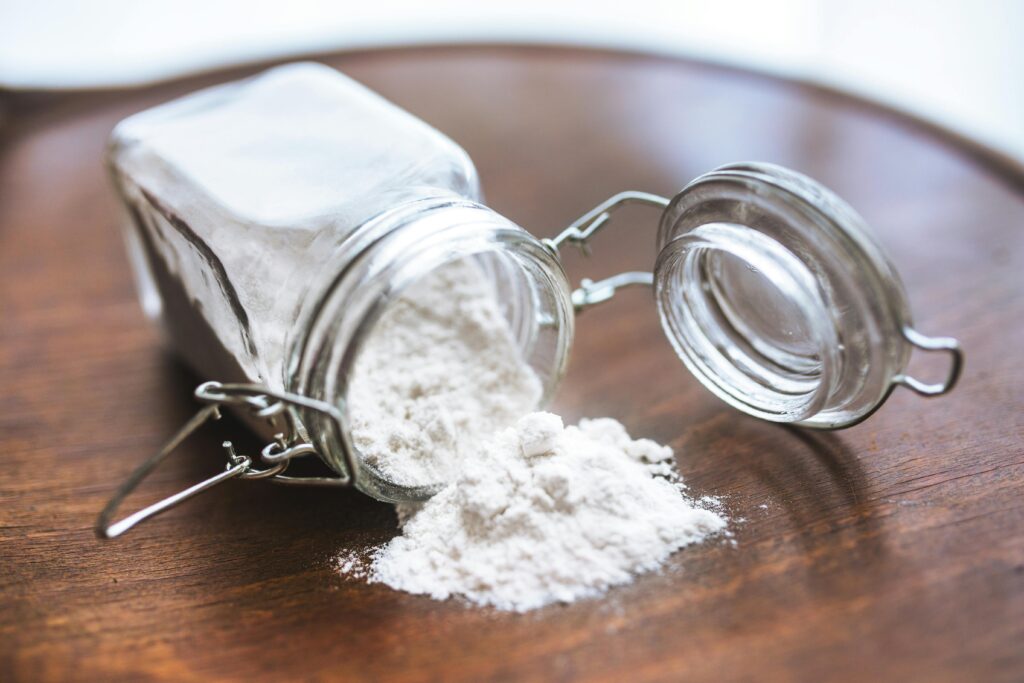What is baking soda
Baking soda, known as sodium bicarbonate (NaHCO3), helps make baking fun! When it’s heated, it releases a gas called carbon dioxide, which makes dough rise. It does the same thing when mixed with something sour like vinegar or lemon juice, whether it’s hot or cold. When you heat baking soda, it turns into carbon dioxide, water, and something called sodium carbonate, which is also used in cleaning.

Action of baking soda
When moisture is present, baking soda reacts with acidic ingredients to release carbon dioxide gas, breaking down into a sodium salt and water. If there’s no acid present but the mixture is heated, the baking soda still releases some carbon dioxide and turns into sodium carbonate. Since many biscuit ingredients, like flour, are slightly acidic, using baking soda can help balance the dough’s pH and improve the biscuits. To ensure the carbon dioxide is used for rising, it’s best to add the baking soda separately, for example, at the end of a multi-stage mixing process along with the flour. It’s important to evenly mix the baking soda throughout the mixture and sift it through a fine sieve to remove any lumps before use.
If there’s too much baking soda in biscuits, it makes them taste weird and gives them a yellowish color. This taste, often called “soda bite,” comes from the high alkalinity, which can sometimes be above pH 8. While some people might enjoy this flavor, most biscuits aim for a pH around 7.0 ± 0.5. To achieve this ideal pH level, it’s important to use the right amount of baking soda, except for certain special biscuit types.
Baking Soda + Edible Acid Ingredient
Bakers have recognized that adding some type of acid ingredient to cake batter improves the cake’s quality. The acid ingredient reacts with the soda, creating the leavening gas, carbon dioxide, and leaving behind an edible residue in the cake. This residue doesn’t damage the cake like the residue from using soda alone would.
Soda is often combined with various acid ingredients to enhance its leavening properties. These acid ingredients include:
- Lemon juice
- Sour Milk
- Buttermilk
- Honey
- Molasses
- Invert sugar
By adding these acidic components to soda, the resulting reaction produces carbon dioxide gas, contributing to the light and airy texture of baked goods.
Here is the comparison between baking soda and baking powder based on different parameters
| Characteristic | Baking Soda | Baking Powder |
|---|---|---|
| Composition | Sodium bicarbonate (NaHCO3) | Mixture of sodium bicarbonate and an acid-reacting compound, often with a filler like starch |
| Activation | Requires an acidic ingredient to produce gas | Activates upon contact with liquid, and again with heat |
| Leavening | Releases carbon dioxide gas when heated or mixed with an acid | Releases carbon dioxide gas when mixed with liquid and again when heated |
| Residue | May leave a washing soda residue if used alone | Generally does not leave residue, provided in appropriate amounts |
| Usage | Ideal for recipes with acidic ingredients | Suitable for recipes without acidic ingredients as it contains its own acidic component |
| Shelf Life | Indefinite if stored properly | Can lose potency over time if not stored properly |
| Role in Baking | Adjusts pH and provides leavening when combined with an acid | Provides leavening in recipes that do not have acidic ingredients |
| Activation Time | Reacts immediately upon contact with acid | Requires some time to react after mixing with liquid |
Conclusion
Baking soda serves as a fundamental ingredient with remarkable leavening capabilities. Its ability to release carbon dioxide gas upon activation by an acidic component is crucial for achieving light, airy textures in baked goods. However, it’s essential to exercise caution when using baking soda alone, as an excess amount may lead to undesirable outcomes such as a dark color and unpleasant taste due to the formation of washing soda residue. Incorporating an acid ingredient alongside baking soda enhances its performance, resulting in better texture and flavor in cakes and other baked treats. With proper understanding and usage, baking soda remains an indispensable tool for bakers, enabling them to create delightful culinary delights with ease.
This blog is so informative